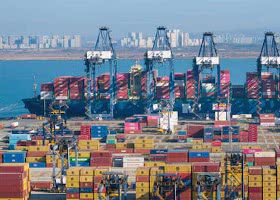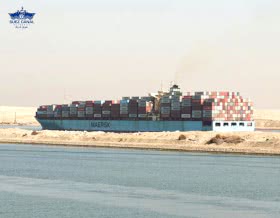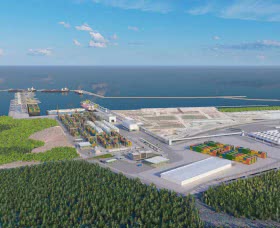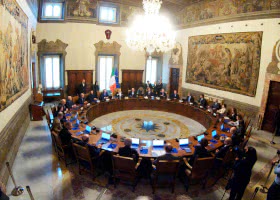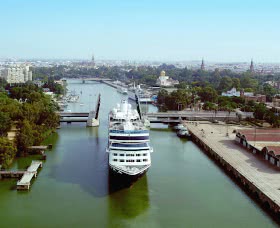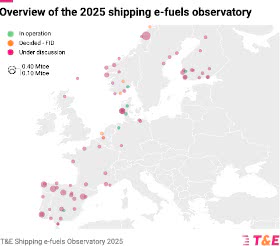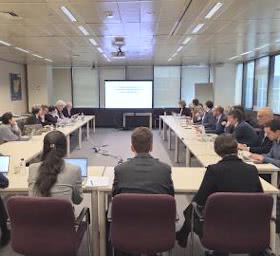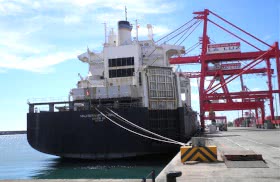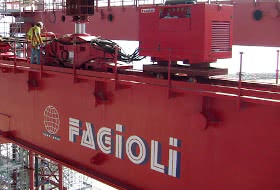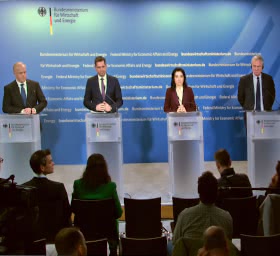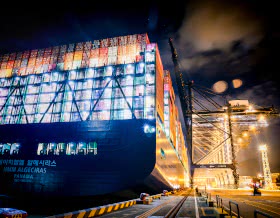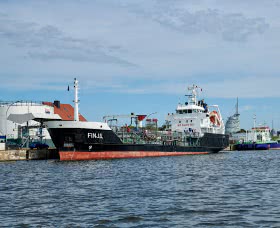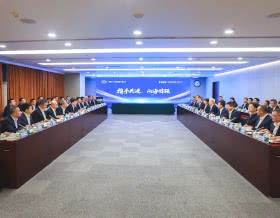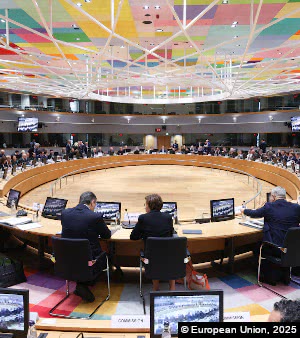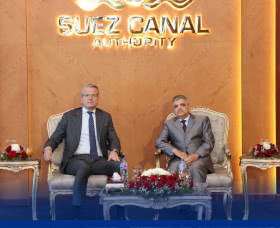Il quadro macroeconomico mondiale ha mostrato negli ultimi tre
anni (dal 1994 al 1996) segnali di miglioramento, dopo il trend
di crescita molto debole del periodo 1991-93.
A livello mondiale la crescita della produzione si '
riportata al di sopra del 3% annuo, ancorch' differenziata per
aree geografiche:
i paesi industrializzati nel triennio passato hanno avuto una
crescita nell'ordine del 2% annuo, con una performance migliore
degli Stati Uniti ed una peggiore del Giappone;
i paesi in via di sviluppo hanno vista l'aumento del proprio
prodotto interno intorno al 6% annuo;
' particolarmente rilevante la crescita dell'Asia, a tassi
annui dell'8%: in particolare i 4 paesi asiatici di recente
industrializzazione (Hong Kong, Singapore, Taiwan e Corea del
Sud) hanno continuato a svilupparsi al ritmo del 7% annuo;
i paesi dell'ex-Urss in transizione verso l'economia di
mercato stanno invertendo la tendenza negativa dei primi anni '90
e tornando ad una crescita, ancorch' limitata.
La situazione italiana ' sostanzialmente allineata con quella
degli altri paesi industrializzati. Alla crisi, culminata nel
1993 con un calo del PIL dell'1.2%, ha fatto seguito una tiepida
ripresa con ritmi compresi fra il 2 ed il 3% annuo.

(*) dati stimati
CRESCITA DEL PIL NELLE DIVERSE
AREE GEOGRAFICHE
Fonte: Fondo Monetario Internazionale - World
Economic Outlook 1996
Scendendo ad analizzare, pi' nello specifico, i livelli di
crescita degli ultimi anni e le previsioni per l'immediato
futuro, si vede che il Fondo Monetario Internazionale per il
medio periodo sostanzialmente conferma l'andamento dell'ultimo
triennio:
per i paesi industrializzati si prevede una crescita media
annua del 2.7%;
per i paesi in via di sviluppo si prevede una crescita del
6.5% medio annuo, pi' accentuata in Asia che in Africa, in
America ed in Medio Oriente.
| |
1995 |
1996 |
1997 (*) |
1998 (*) |
| Mondo |
3.7 |
4.0 |
4.4 |
4.4 |
| Paesi industrializzati |
2.1 |
2.3 |
2.7 |
2.7 |
| Paesi in via di sviluppo |
6.0 |
6.5 |
6.6 |
6.5 |
| Paesi in transizione |
- 0.8 |
0.1 |
3.0 |
4.8 |
(*) dati stimati
CRESCITA DEL PIL NELLE DIVERSE
AREE GEOGRAFICHE
Fonte: Fondo Monetario Internazionale - World
Economic Outlook 1997
Si rileva tuttavia come il panorama in Italia e nell'Unione
Europea si presenta a tinte grigie.
Nel 1996 la crescita registrata dall'Istat in Italia ' stata
appena dello 0.7%, dopo l'espansione del biennio precedente
(+2.2% e +2.9% rispettivamente nel 1994 e nel 1995).
Anche negli altri paesi dell'Unione Europea, impegnati al
rispetto dei criteri di convergenza imposti dal Trattato di
Maastricht, la congiuntura non ' espansiva.
Il volume degli scambi di merci nel 1996 ' cresciuto
del 4%, un aumento simile a quello riportato nel periodo 1990-93,
secondo i dati della WTO.
Questo significa che dopo due anni di crescita molto sostenuta
degli scambi (9% nel '94; 8,5% nel '95), il 1996 ' stato un anno
di decelerazione, nonostante l'andamento della produzione
mondiale si sia mantenuto su livelli stabili.
In conseguenza di ci', il rapporto fra crescita del commercio
e crescita della produzione, che aveva raggiunto il massimo a
met' degli anni '90, si ' ridotto drasticamente.
Questo cambiamento appare attribuibile principalmente allo
sviluppo asiatico, dove l'aumento degli scambi ' stato inferiore
a quello della produzione.
Va comunque rilevato come la crescita degli scambi
(esportazioni e importazioni) si sia mantenuta doppia rispetto
alla crescita della produzione in Europa Occidentale, Nord
America e America Latina.
Il rallentamento della crescita delle esportazioni misurate in
valore ' stato ancora pi' accentuato, passando da un +20% nel
1995 al +4% nel 1996, a causa della stagnazione dei prezzi in
dollari delle merci scambiate.
Il commercio in prodotti che avevano beneficiato di trend di
prezzo e/o di domanda molto forti nel 1995, come le attrezzature
per ufficio e telecomunicazioni, ferro e acciaio e metalli non
ferrosi, ' stato influenzato negativamente dal declino dei
prezzi e dall'indebolimento della domanda. Al contrario, le
esportazioni di combustibili sono cresciute in valore del 10% in
seguito al rialzo dei prezzi del petrolio.
Per ci' che riguarda gli scambi di servizi, la crescita in
valore nel 1996 ' stata del 5%, anche in questo caso in
rallentamento rispetto agli anni immediatamente precedenti.
La frenata della crescita ' stata pi' accentuata in Europa
Occidentale ed in Asia rispetto che in Nord America, anche per
effetto della situazione congiunturale.
Le prime indicazioni fornite dalla WTO relativamente ai tre
settori dei servizi mostrano che l'incremento pi' basso ha
riguardato proprio i trasporti, mentre viaggi e turismo sono
stati in media e la categoria "altri" (servizi
finanziari ed assicurativi, brevetti, royalties, servizi per
costruzioni e altri) continua ad essere la pi' dinamica.
Il fattore che ha portato alla quasi stagnazione del valore
degli scambi nei servizi di trasporto ' stata la debolezza del
commercio di beni, unitamente al contenimento dei prezzi dei
servizi stessi.
Innanzitutto occorre analizzare come si distribuisce il
commercio di merci nelle varie aree geografiche, partendo dai
dati forniti dalla WTO e risalenti al 1994.
La quota maggiore ' detenuta dall'Europa Occidentale, che
partecipa al commercio nella misura del 44%.
Seguono l'Asia, con una quota intorno al 25%, ed il Nord
America, che detiene il 18% degli scambi mondiali.
Le altre macro-aree hanno quote comprese fra il 2% ed il 5%.
Escludendo il commercio infra-regionale e focalizzandosi su
quello fra le macro-aree, che ' quello pi' interessante dal
punto di vista del trasporto marittimo, la situazione si modifica
considerevolmente.
Emerge infatti come in Europa Occidentale il commercio
all'interno dell'area pesi per il 70% del totale, mentre questa
percentuale sia notevolmente inferiore per l'Asia (52%) e per il
Nord America (38%).
Il risultato ' che l'Europa Occidentale detiene il 13% degli
scambi fra le macro-aree, mentre l'Asia ed il Nord America
detengono il 12% ciascuno.
Si delinea dunque una tripolarit' degli scambi incentrata su
Unione Europea, Stati Uniti ed Asia, con particolare attenzione
all'Estremo Oriente.

QUOTE DELLE MACRO-AREE NELLO
SCAMBIO MONDIALE DI MERCI
(percentuali basate sugli scambi
in valore, anno 1994)
Fonte: WTO
L'analisi dei dati congiunturali per macro-area geografica
mostra delle differenze significative: il rallentamento nella
crescita degli scambi di merci ' stato pi' sentito in
Asia, Europa occidentale e nei paesi in transizione, mentre '
stato meno pronunciato in Nord America ed in America Latina.
| Esportazioni
|
|
Importazioni
|
| Media 1990-96
|
1995 |
1996 |
|
Media 1990-96
|
1995 |
1996 |
| 5.5 |
8.5 |
4.0 |
Mondo
|
6.0 |
8.5 |
4.5 |
| 7.0 |
9.5 |
5.5 |
Nord America
|
7.0 |
8.0 |
5.5 |
| 8.5 |
12.0 |
11.0 |
America Latina
|
11.0 |
3.0 |
10.5 |
| 5.0 |
8.0 |
4.0 |
Unione Europea
|
4.0 |
6.0 |
2.5 |
| 3.5 |
14.5 |
3.5 |
Economie in
transizione |
2.5 |
11.5 |
12.0 |
| 7.0 |
9.5 |
2.5 |
Asia |
9.5 |
14.0 |
4.5 |
| 1.0 |
3.5 |
-0.5 |
Giappone
|
6.0 |
12.5 |
2.5 |
| 10. |
14.5 |
3.5 |
6
"tigri" asiatiche |
10.5 |
15.5 |
4.0 |
ANDAMENTO DEL VOLUME DEGLI
SCAMBI DI MERCI PER AREA GEOGRAFICA, 1990-96
(variazioni percentuali annue)
Fonte: WTO
A livello di singoli paesi, vale la pena sottolineare quali
sono state le performance pi' dinamiche nel periodo 1990-96.
I paesi pi' brillanti dal punto di vista dei commerci, come
si pu' vedere nella Tabella che segue, sono stati Argentina,
Cina, Indonesia, Corea del Sud, Malaysia, Messico, Filippine,
Singapore e Thailandia, che figurano sia fra gli esportatori sia
fra gli importatori.
Fra i paesi occidentali figurano solo Irlanda, Spagna e
Turchia.
| Esportatori
|
Importatori
|
| Malaysia |
18 |
Argentina |
34 |
| Filippine |
17 |
Polonia |
22 |
| Cina |
16 |
Malaysia |
18 |
| Tailandia |
16 |
Filippine |
18 |
| Singapore |
15 |
Cina |
17 |
| Messico |
15 |
Brasile |
17 |
| Irlanda |
13 |
Colombia |
16 |
| Kuwait |
12 |
Emirati Arabi
Uniti |
15 |
| Corea del Sud |
12 |
Cile |
15 |
| Indonesia |
12 |
Messico |
14 |
| Argentina |
12 |
Singapore |
14 |
| India |
11 |
Corea del Sud
|
14 |
| Spagna |
11 |
Tailandia |
13 |
| |
|
Indonesia
|
12 |
| |
|
Turchia
|
11 |
| |
|
Israele
|
11 |
| |
|
Taiwan |
11 |
PAESI PIU' DINAMICI NEL
COMMERCIO, 1990-96
(variazioni annue percentuali
degli scambi misurati in dollari)
La fase di deprezzamento della lira, susseguente all'uscita
della moneta italiana dal Sistema Monetario Europeo nel 1992, ha
portato ad una notevole dinamica dei movimenti import-export
italiani nel corso degli anni '90.
Tale dinamica favorevole sembra si stia mantenendo anche nel
1996, anno in cui i cambi si sono nuovamente stabilizzati.
Gli scambi internazionali misurati a quantit' nel periodo
1990-1995 sono cresciuti complessivamente dell'11% circa, con un
incremento molto pi' accentuato delle esportazioni (+26.8%)
rispetto alle importazioni (+6.7%).
| Anno |
Import |
Var.% |
Export |
Var.% |
Totale |
Var.% |
| 1990 |
266,464,973 |
|
73,410,692 |
|
339,875,665 |
|
| 1991 |
271,902,662 |
2.0% |
74,422,493 |
1.4% |
346,325,155 |
1.9% |
| 1992 |
272,730,728 |
0.3% |
80,332,297 |
7.9% |
353,063,025 |
1.9% |
| 1993 |
257,853,849 |
-5.5% |
88,273,404 |
9.9% |
346,127,253 |
-2.0% |
| 1994 |
271,510,473 |
5.3% |
91,164,624 |
3.3% |
362,675,097 |
4.8% |
| 1995 |
284,371,225 |
4.7% |
93,100,669 |
2.1% |
377,471,894 |
4.1% |
MOVIMENTI IMPORT-EXPORT IN
ITALIA A QUANTITA'
(tonnellate)
Fonte: Ministero dei Trasporti e della
Navigazione
I dati sugli scambi a valore mostrano che gli incrementi sono
stati ancora superiori.
Nello stesso periodo 1990-1995 le importazioni sono cresciute
del 52.7% e le esportazioni addirittura dell'85%.
Questo ha portato il saldo fra esportazioni ed importazioni in
positivo.
| Anno |
Import |
Var.% |
Export |
Var.% |
Saldo |
| 1990 |
217,723,207 |
|
203,496,142 |
|
-14,227,065 |
| 1991 |
225,767,103 |
3.7% |
209,745,393 |
3.1% |
-16,021,710 |
| 1992 |
231,989,299 |
2.8% |
219,399,352 |
4.6% |
-12,589,947 |
| 1993 |
232,991,206 |
0.4% |
266,214,442 |
21.3% |
33,223,236 |
| 1994 |
272,381,647 |
16.9% |
308,045,632 |
15.7% |
35,663,985 |
| 1995 |
332,409,083 |
22.0% |
376,785,707 |
22.3% |
44,376,624 |
| 1996 |
319,396,371 |
- 3.9% |
386,947,368 |
2.7% |
67,550,997 |
MOVIMENTI IMPORT-EXPORT IN
ITALIA A VALORE
(milioni di Lire)
Fonte: Ministero dei Trasporti e della
Navigazione, ISTAT
Come si pu' vedere dai dati riportati, il 1996 ha rivelato
per' un'inversione di tendenza, evidenziando una lieve flessione
nelle importazioni di merci (misurate in valore), mentre le
esportazioni sono cresciute del 2.7%, valore inferiore alle
performance registrate negli anni precedenti. Ci' nonostante il
saldo commerciale con l'estero ' ulteriormente cresciuto,
superando i 60.000 miliardi di Lire.
Se si considera per' che il cambio medio con il dollaro
americano nel 1996 ' stato pari a 1,543 lire rispetto a 1,629,
dato medio del 1995, riportando il volume degli scambi in dollari
USA si rileva come le importazioni siano rimaste sostanzialmente
stabili (+ 0,5%), mentre la crescita delle esportazioni, in
valore, risulta pi' sensibile (+ 7,2%).
Analizzando i principali paesi destinatari delle esportazioni
italiane nel 1996, si rileva la prevalenza dei paesi UE (55.3%
del totale delle esportazioni italiane) rispetto a quelli non
comunitari (44.7%). Passando ad analizzare i singoli paesi,
quelli con il maggior volume di scambi con l'Italia -valutando
sempre il valore totale delle esportazioni in USD- sono in
assoluto la Germania (17.4%) e la Francia (12.5%), mentre tra i
paesi non UE prevalgono gli Stati Uniti (7.3%), i paesi
dell'Europa centrale e dell'Est (5.8%) ed i paesi asiatici di
nuova industrializzazione (4.3%).
| |
1995 |
1995 %
|
1996 |
1996 %
|
96/95 var. %
|
| Paesi UE |
134,101 |
57.3% |
138,563 |
55.3% |
3.3% |
| Francia |
30,579 |
13.1% |
31,366 |
12.5% |
2.6% |
| Belgio / Lussemburgo |
6,761 |
2.9% |
6,906 |
2.8% |
2.1% |
| Olanda |
6,961 |
3.0% |
7,365 |
2.9% |
5.8% |
| Germania |
44,156 |
18.9% |
43,682 |
17.4% |
- 1.1% |
| Gran Bretagna |
14,579 |
6.2% |
16,193 |
6.5% |
11.1% |
| Irlanda |
943 |
0.4% |
1,001 |
0.4% |
6.1% |
| Danimarca |
2,045 |
0.9% |
2,111 |
0.8% |
3.3% |
| Grecia |
4,470 |
1.9% |
4,712 |
1.9% |
5.4% |
| Portogallo |
3,270 |
1.4% |
3,326 |
1.3% |
1.7% |
| Spagna |
11,394 |
4.9% |
12,292 |
4.9% |
7.9% |
| Svezia |
2,272 |
1.0% |
2,503 |
1.0% |
10.2% |
| Finlandia |
1,067 |
0.5% |
1,202 |
0.5% |
12.6% |
| Austria |
5,603 |
2.4% |
5,902 |
2.4% |
5.3% |
| Paesi non UE |
99,893 |
42.7% |
112,213 |
44.7% |
12.3% |
| EFTA |
9,767 |
4.2% |
10,561 |
4.2% |
8.1% |
| Europa dell'Est e centrale
|
11,461 |
4.9% |
14,661 |
5.8% |
27.9% |
| OPEC |
7,775 |
3.3% |
8,743 |
3.5% |
12.5% |
| USA |
16,848 |
7.2% |
18,402 |
7.3% |
9.2% |
| Cina |
2,695 |
1.2% |
2,868 |
1.1% |
6.4% |
| Giappone |
5,346 |
2.3% |
5,583 |
2.2% |
4.4% |
| Paesi asiatici NIC |
9,460 |
4.0% |
10,735 |
4.3% |
13.5% |
| Altri |
36,541 |
15.6% |
40,660 |
16.2% |
11.3% |
| TOTALE |
233,993 |
100 |
250,776 |
100% |
7.2% |
ESPORTAZIONI ITALIANE 1995 -
1996
(milioni di USD)
Fonte: elaborazione World Transport and Trade
-Saima Avandero Group- da varie fonti
Se si valorizzano invece i volumi delle importazioni italiane
nel 1996, tra i principali paesi di scambio prevalgono i paesi
UE, con una quota sul totale delle importazioni italiane che sale
al 60.8%, rispetto ai paesi non comunitari (39.2%). Passando ad
analizzare i singoli paesi, quelli con il maggior volume di
scambi con l'Italia -considerando il valore totale delle
importazioni in USD- rimangono la Germania (18.5%) e la Francia
(13.5%); tra i paesi non UE prevalgono i paesi OPEC (6.2%),
seguiti dai paesi dell'Europa centrale e dell'Est (5.8%) e dagli
Stati Uniti (4.9%).
Riorganizzando il commercio mondiale per tipologie di prodotti
trasportabili, con l'esclusione delle rinfuse solide e liquide,
ed ordinando le quote degli scambi mondiali in base al valore
degli scambi, si ottiene che la quota maggiore ' rappresentata
da macchine e apparecchiature per il trasporto (con l'eccezione
di prodotti automobilistici, per ufficio e telecomunicazioni),
con il 18%.
Seguono i prodotti agricoli, le macchine per ufficio e
telecomunicazioni ed i prodotti estrattivi, tutti con quote fra
l'11% ed il 13%.
Nel grafico che segue sono rappresentate le varie categorie
del commercio con le rispettive quote sul totale del commercio
mondiale.

ESPORTAZIONI MONDIALI DI MERCI
PER TIPOLOGIA DI PRODOTTO
(quote percentuali basate sui
valori)
Fonte: WTO
Dall'inizio del decennio queste percentuali si sono modificate
poco, con due eccezioni: i prodotti estrattivi hanno ridotto la
propria importanza dal 14% all'11%, mentre le macchine per
ufficio e telecomunicazioni sono cresciute dal 9% ad oltre il
12%.
Nel secondo dopoguerra si ' verificato tutti gli anni che, a
livello mondiale, la crescita del commercio di beni ha superato
la crescita della produzione. Secondo le stime della World Trade
Organization nel periodo 1950-1994 il volume del commercio
mondiale ' cresciuto in media del 6% all'anno, mentre la
produzione ' cresciuta a ritmi intorno al 4% annuo.
Questo significa che, nei 45 anni considerati, la produzione
mondiale di beni ' aumentata di 5,5 volte, mentre il commercio
si ' moltiplicato 14 volte in termini reali.
I dati della WTO evidenziano come questa tendenza si sia
accentuata nel corso dell'ultimo decennio. Nel decennio 1974-1984
il rapporto fra crescita del commercio e crescita della
produzione ' stato di appena 1.2 punti, mentre nel periodo
1984-1994 ' stato di 2.8 punti.
In altri termini nell'ultimo decennio il commercio mondiale '
aumentato tre volte pi' rapidamente della produzione.
Questo si verifica anche disaggregando i dati nei tre settori
-agricolo, estrattivo e manifatturiero- e prendendo in
considerazione il commercio di servizi; l'unica eccezione '
rappresentata dal settore estrattivo nel periodo 1974-1984, per
cui si ' verificata una contrazione dei commerci.
In sintesi a partire dal dopoguerra ' in corso un processo di
integrazione economica che ha subito un rallentamento nel periodo
della crisi petrolifera, ma ha conosciuto una forte accelerazione
negli anni '90.
Le definizioni e descrizioni di questo fenomeno di
globalizzazione sono pi' qualitative che quantitative. Secondo
l'OCSE ' il processo per effetto del quale i mercati e la
produzione in paesi diversi divengono sempre pi'
interdipendenti, a causa delle dinamiche del commercio di beni e
servizi e dei flussi di capitali e tecnologie.
L'interdipendenza ' quindi rivelata non solo dalla crescita
degli scambi in rapporto al prodotto, ma anche dall'aumento degli
investimenti stranieri, delle sub-forniture internazionali, dei
brevetti internazionali, di fusioni, acquisizioni, joint ventures
ed accordi fra imprese di diverse nazioni.
Non ' questa la sede per approfondire le cause del fenomeno.
Tuttavia vale la pena citare i tre elementi che maggiormente
hanno influito sul processo di globalizzazione dell'economia:
le politiche governative improntate alla liberalizzazione
degli scambi e dei flussi di capitali;
le innovazioni tecnologiche che riducono i costi di
comunicazione e trasporto;
l'evoluzione delle strategie delle imprese e degli
investitori, che si muovono alla ricerca di nuovi mercati di
approvvigionamento e di sbocco, in questo determinando ed essendo
facilitati dai due fattori precedenti.
Il processo di globalizzazione ed integrazione dell'economica
ha profondamente modificato, in pratica ridisegnato, le modalit'
di produzione e distribuzione dei prodotti sul pianeta.
Rammentiamo per sommi capi la natura, le caratteristiche e le
implicazioni di questi fenomeni.
- La globalizzazione dei processi
manifatturieri.
I processi manifatturieri delle imprese dei paesi pi'
industrializzati tendono ad essere segmentati in fasi intermedie
ed allocati in varie aree geografiche secondo una logica di
ottimizzazione dei costi. Ci' significa diminuire la domanda di
trasporto a lungo raggio di materie prime ed aumentare la domanda
di trasporto di prodotti finiti e/o intermedi su tratte
tendenzialmente pi' brevi.
- La riallocazione industriale.
Alcuni paesi sviluppati stanno trasferendo interi complessi
produttivi in paesi con basso costo di mano d'opera o per evitare
restrizioni di quote od altre limitazioni di mercato. Ci'
determina una diminuzione di domanda di trasporto di prodotti
finiti e di percorrenza per le materie prime.
- L'aggiunta di valore all'origine.
Alcuni paesi emergenti, produttori di materie prime, tendono
ad avviare la loro industrializzazione effettuando alcune prime
trasformazioni. Tipico ' il caso di industrie petrolchimiche
allocate immediatamente a valle dei paesi di estrazione. Ci'
tende a ridurre le quantit' globali trasportate ed a modificare
il mix tra prodotti grezzi e prodotti intermedi o finiti.
- L'integrazione dei mercati regionali
Le economie delle aree emergenti, specie nel Far East,
tendono, nella loro fase di crescita, ad intensificare gli scambi
non solo da e per i paesi piu' sviluppati dell'Europa e degli
USA, ma anche tra i diversi paesi della stessa area regionale.
Questo fattore determinera' probabilmente sempre maggiori
effetti sui traffici marittimi sia in termini quantitativi che di
direzione nei flussi.
Questa metodologia produttiva puo' inserirsi all'interno del
processo di articolazione e verticalizzazione di una impresa
ovvero connettere una catena produttiva basata sulla logica
cliente-fornitore. In entrambi i casi i riflessi sul settore
trasportistico sono i medesimi: diminuzione dei lotti in termini
di quantita' unitarie, crescita della rapidita' ed affidabilita'
della distribuzione (spesso con qualita' certificata), visione
unitaria door-to-door dell'intera catena trasportistica.
- La modifica nelle tecnologie progettuali e
produttive
La ricerca industriale in tutti i settori produttivi tende, al
fine di ottimizzare i costi, a minimizzare il peso dei
componenti, a sperimentare nuove tipologie di materiali, a
ottimizzare le forme dei prodotti (processo di
miniaturizzazione). Queste metodologie produttive spesso si
accompagnano alle tecniche just in time e determinano,
rafforzandoli, gli stessi impatti.
- La conservazione delle materie prime
Sia per motivazioni economiche, che per la crescente pressione
dei movimenti ambientalisti e' in atto nei paesi piu'
industrializzati una tendenza a sostituire una quota di materie
prime con l'utilizzo sempre maggiore del riciclaggio dei rifiuti
e dei rottami. Cio' determina una tendenziale contrazione della
domanda di trasporto nel tanker e nelle rinfuse solide.
Le tecniche di produzione dell'energia tendono a modificarsi
anche in relazione ad aspetti ambientali nei paesi piu'
sviluppati. L'utilizzo del gas, ad esempio, viene visto con
maggior favore rispetto al petrolio o al carbone: ci' determina
modificazioni nel mix e nelle quantita' trasportate.






